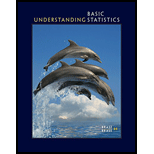
Concept explainers
Critical Thinking: Interpreting Computer Printouts We use the form
A Minitab printout provides
| Predictor | Coef | SE Coef | T | P |
| Constant | 318.16 | 28.31 | 11.24 | 0.002 |
| Elevation | -30.878 | 3.511 | -8.79 | 0.003 |
s = 11.8603 R-Sq = 96.3%
Notice that “Elevation” is listed under “Predictor.” This means that elevation is the explanatory variable x. Its coefficient is the slope b. “Constant” refers to a in the equation
(a) Use the printout to write the least-squares equation.
(b) For each 1000-foot increase in elevation, how many fewer frost-free days are predicted?
(c) The printout gives the value of the coefficient of determination
(d) Interpretation What percentage of the variation in y can he explained by the corresponding variation in x and the least-squares line? What percentage is unexplained?
Want to see the full answer?
Check out a sample textbook solution
Chapter 4 Solutions
Understanding Basic Statistics
- A marketing agency wants to determine whether different advertising platforms generate significantly different levels of customer engagement. The agency measures the average number of daily clicks on ads for three platforms: Social Media, Search Engines, and Email Campaigns. The agency collects data on daily clicks for each platform over a 10-day period and wants to test whether there is a statistically significant difference in the mean number of daily clicks among these platforms. Conduct ANOVA test. You can provide your answer by inserting a text box and the answer must include: also please provide a step by on getting the answers in excel Null hypothesis, Alternative hypothesis, Show answer (output table/summary table), and Conclusion based on the P value.arrow_forwardA company found that the daily sales revenue of its flagship product follows a normal distribution with a mean of $4500 and a standard deviation of $450. The company defines a "high-sales day" that is, any day with sales exceeding $4800. please provide a step by step on how to get the answers Q: What percentage of days can the company expect to have "high-sales days" or sales greater than $4800? Q: What is the sales revenue threshold for the bottom 10% of days? (please note that 10% refers to the probability/area under bell curve towards the lower tail of bell curve) Provide answers in the yellow cellsarrow_forwardBusiness Discussarrow_forward
- The following data represent total ventilation measured in liters of air per minute per square meter of body area for two independent (and randomly chosen) samples. Analyze these data using the appropriate non-parametric hypothesis testarrow_forwardeach column represents before & after measurements on the same individual. Analyze with the appropriate non-parametric hypothesis test for a paired design.arrow_forwardShould you be confident in applying your regression equation to estimate the heart rate of a python at 35°C? Why or why not?arrow_forward

 Glencoe Algebra 1, Student Edition, 9780079039897...AlgebraISBN:9780079039897Author:CarterPublisher:McGraw Hill
Glencoe Algebra 1, Student Edition, 9780079039897...AlgebraISBN:9780079039897Author:CarterPublisher:McGraw Hill Elementary Linear Algebra (MindTap Course List)AlgebraISBN:9781305658004Author:Ron LarsonPublisher:Cengage Learning
Elementary Linear Algebra (MindTap Course List)AlgebraISBN:9781305658004Author:Ron LarsonPublisher:Cengage Learning



